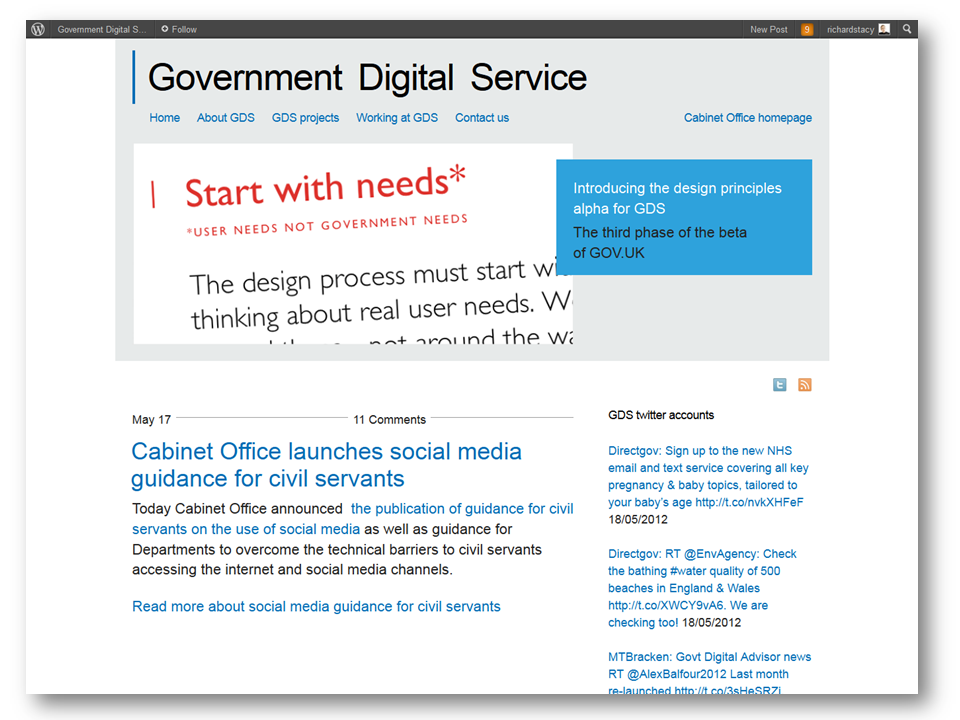UK Government Digital Service – a brilliant example of a social content hub
 I often get asked to recommend social media tools (e.g. should we use Twitter? What should be our Twitter strategy?). My reply is always “forget the tools, you can’t have a strategy based on the use of a tool, a carpenter doesn’t have a hammer strategy. Work out what you want to achieve and this will then tell what tools you need and how to use them.” That said, there are two basic functions that any organisation who wishes to operate in the social digital space needs to address and these do have tools attached which I am happy to recommend. The first function is real-time listening (for which I recommend Socialmention and Netvibes) and the second is publication (for which I recommend WordPress).
I often get asked to recommend social media tools (e.g. should we use Twitter? What should be our Twitter strategy?). My reply is always “forget the tools, you can’t have a strategy based on the use of a tool, a carpenter doesn’t have a hammer strategy. Work out what you want to achieve and this will then tell what tools you need and how to use them.” That said, there are two basic functions that any organisation who wishes to operate in the social digital space needs to address and these do have tools attached which I am happy to recommend. The first function is real-time listening (for which I recommend Socialmention and Netvibes) and the second is publication (for which I recommend WordPress).
The publication function involves creating a socially optimised publishing platform designed to launch content into digital space rather than be a content destination (or content prison as I like to call websites). I call this a content hub, or a social hub, or sometimes a social content hub, or a social media newsroom. I never want to call it a blog, because this creates some unhelpful preconceptions and means you fall into the old Gutenberg trap of describing content by its means of distribution. You can see the problem. Describing one of these things and understanding how it is different from a website is often quite difficult. It requires both a conceptual understanding of the fact that information doesn’t live in digital places anymore, but in digital spaces (often created when people ask Google questions) and a structural understanding of how you now identify and optimise individual bits of information (posts) as distinct from sources of information (websites).
I therefore tend to fall back on examples and good ones are quite hard to find. I was therefore delighted to discover the ‘socially-optimised-publishing-platfrom / content hub / social hub / social media newsroom’ from the UK Government Digital Service. It is brilliant. It uses a WordPress.com template (albeit a premium one that costs about $70 rather than one of the free ones), with some minor customisation. It is beautifully simple and clean – information that is being published (launched) on the left and content from the various GDS Twitter accounts on the right – with two simple subscription options (RSS and Twitter) clearly available top right.
The issue of content segmentation is covered by use of categories which accord to each of the GDS project areas. The GDS positions these as separate blogs, when in reality they are simply category pages. This represents a very elegant way of overcoming what is often a common structural and design issue for many organisations, namely how to accommodate the increasing need to give identity to very specific subject areas, without creating a huge mess of individual blogs and platforms. Add a new specialism or project and you simply add a category – the work of an instant.
And perhaps best of all, here is an organisation of the scale and resource (and presumed competence) of the UK Government using something that would fit within the budget and technical competence of even the smallest organisation. It also gives me some faith that there are people at the heart of Government who understand social media.

2 comments